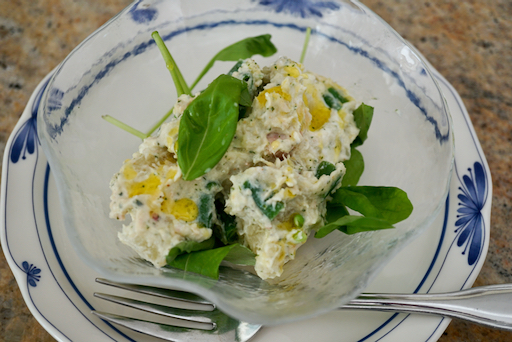Ingredients:
1/2 gallon of whole milk
1/3 cup vinegar (she used sushi vinegar)
(The recipe also suggests the juice from one or two lemons, or 1/2 tsp citric acid)
1 tsp salt (or more to taste)
Suggested additions:
Add 1 1/2 tsp salt to curd after whey has been drained away
Add chopped jalapeño to curd before pressing
Add 2 Tbs. Olive oil to curd before pressing.
Directions:
Slowly heat the milk to 200 degrees F stirring constantly. After it reaches temperature remove from the heat pour in the vinegar and salt and stir gently to combine. Leave the pot undisturbed for 10 minutes. It should be separated into clumps of milky white curds and watery yellow colored whey. Using a spoon gently stir the mixture. If there is still a lot of unseparated milk add another tablespoon of the vinegar. Line a strainer with cheese cloth and set it over a bowl. Using a large spoon transfer the curds to the strainer. Let the curds drain for 10 to 60 minutes depending on how dry you would like the ricotta to be. (If it is too dry add some of whey reserved in the draining bowl).
Directions:
Slowly heat the milk to 200 degrees F stirring constantly. After it reaches temperature remove from the heat pour in the vinegar and salt and stir gently to combine. Leave the pot undisturbed for 10 minutes. It should be separated into clumps of milky white curds and watery yellow colored whey. Using a spoon gently stir the mixture. If there is still a lot of unseparated milk add another tablespoon of the vinegar. Line a strainer with cheese cloth and set it over a bowl. Using a large spoon transfer the curds to the strainer. Let the curds drain for 10 to 60 minutes depending on how dry you would like the ricotta to be. (If it is too dry add some of whey reserved in the draining bowl).
My wife then pressed the curds to form a block of cheese. (Since we didn’t have a cheese press she used the tofu press and it worked just fine.) The final block is shown below after we sliced off a piece to see how it tasted.
By-the-way, the whey drained from the cheese is very good. It has a slightly milky, slightly tart, slightly salty taste. It would be good to add to soups or use in breads.
The cheese was very nice. It had a slight tartness from the sushi vinegar which was a nice addition. The overall taste was accentuated by the salt that was added. Since the cheese was fairly mild we served it with the jalapeno sauce I had made recently and the combination was so good we decided the marinate pieces of the cheese in the sauce. We then served it with the marinade on small squares of toated bread. It was excellent.
By-the-way, the whey drained from the cheese is very good. It has a slightly milky, slightly tart, slightly salty taste. It would be good to add to soups or use in breads.
The cheese was very nice. It had a slight tartness from the sushi vinegar which was a nice addition. The overall taste was accentuated by the salt that was added. Since the cheese was fairly mild we served it with the jalapeno sauce I had made recently and the combination was so good we decided the marinate pieces of the cheese in the sauce. We then served it with the marinade on small squares of toated bread. It was excellent.



















